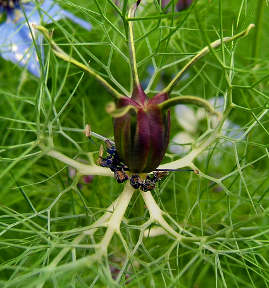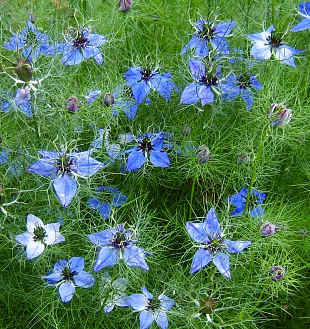 Nigella
damascena
Nigella
damascenaLove-in-a-Mist
The name of this plant comes from a legend about the Emperor Frederick I (1125-1190), who drowned in a shallow Turkish river as he was leading a Crusade. According to the story, he was seduced by a water spirit with green hair who drowned him in the hip-deep water. This plant sprang up at the shore and displays the water spirit's hair. We like the contrast between the image of the mighty emperor and the delicate, innocent-looking plant (by the way, the "spikes" are very soft and not sharp).
 In India, the seeds are used as a sachet to keep
bugs out of clothing.
Rubbing them releases the scent of strawberry jam, which is what its
essential oil smells like. The seeds are used in cooking--flavoring for
curry and a sprinkle on bread--and supposedly taste like nutmeg but are
nowhere near as good as those of its relative, Nigella sativa (black
cumin). At one time the seeds were roasted and an ill person breathed
in the
"fumes" to "drie the braine," and it is mentioned by Dioscorides and
Theophrastus for digestive complaints. This native of warm areas of
Europe, North Africa, and the Near East was introduced into England in
1570 and since then has become naturalized in various places. Thomas
Jefferson grew love-in-a-mist in his garden. It was later popularized
by
gardener Gertrude Jekyll in her recreations of cottage gardens, and
some varieties bear her name. Indeed, it makes good cut flowers, and
the pods are nice dried--try them as an addition to wreaths and
bouquets for handfasting. Bees enjoy the flowers. This plant looks
especially nice planted with silvery companions like lavender or lamb's
ears. Love-in-a-mist is also known as wild fennel, ragged lady, spiders
legs, jack in prison, lady in the
green, love entangled, love-in-a-tangle, love-in-a-puzzle,
love-in-the-shade, Our Lady In The Shade, devil-in-a-bush,
lady in a bower, garden black seed, hair of Venus, black caraway,
and Damascus black cumin.
In India, the seeds are used as a sachet to keep
bugs out of clothing.
Rubbing them releases the scent of strawberry jam, which is what its
essential oil smells like. The seeds are used in cooking--flavoring for
curry and a sprinkle on bread--and supposedly taste like nutmeg but are
nowhere near as good as those of its relative, Nigella sativa (black
cumin). At one time the seeds were roasted and an ill person breathed
in the
"fumes" to "drie the braine," and it is mentioned by Dioscorides and
Theophrastus for digestive complaints. This native of warm areas of
Europe, North Africa, and the Near East was introduced into England in
1570 and since then has become naturalized in various places. Thomas
Jefferson grew love-in-a-mist in his garden. It was later popularized
by
gardener Gertrude Jekyll in her recreations of cottage gardens, and
some varieties bear her name. Indeed, it makes good cut flowers, and
the pods are nice dried--try them as an addition to wreaths and
bouquets for handfasting. Bees enjoy the flowers. This plant looks
especially nice planted with silvery companions like lavender or lamb's
ears. Love-in-a-mist is also known as wild fennel, ragged lady, spiders
legs, jack in prison, lady in the
green, love entangled, love-in-a-tangle, love-in-a-puzzle,
love-in-the-shade, Our Lady In The Shade, devil-in-a-bush,
lady in a bower, garden black seed, hair of Venus, black caraway,
and Damascus black cumin. How to grow love-in-a-mist:
 Direct sow seeds outside as soon as the soil can be
worked in spring.
When direct sowing, thoroughly work up the soil, breaking up all clods, and
gently smooth flat, water, sprinkle on the seeds, lightly cover them
with a layer of fine compost,
and then gently firm with the flat of a rake or hoe. You can also
direct sow in fall if your winters are not harsh, or you can start
inside, but they get a tap root and sometimes such plants can be cranky
to transplant. The seeds germinate in 2 weeks at room temperature. Set
6"/15cm apart. Site them in full sun but away from legumes, which
love-in-a-mist can hinder. This plant gets 24"/60 cm tall and produces
pink, white, mauve, purple, and blue flowers and maroon-striped Cthulhu
pods. It self-seeds readily. General
growing
info
Direct sow seeds outside as soon as the soil can be
worked in spring.
When direct sowing, thoroughly work up the soil, breaking up all clods, and
gently smooth flat, water, sprinkle on the seeds, lightly cover them
with a layer of fine compost,
and then gently firm with the flat of a rake or hoe. You can also
direct sow in fall if your winters are not harsh, or you can start
inside, but they get a tap root and sometimes such plants can be cranky
to transplant. The seeds germinate in 2 weeks at room temperature. Set
6"/15cm apart. Site them in full sun but away from legumes, which
love-in-a-mist can hinder. This plant gets 24"/60 cm tall and produces
pink, white, mauve, purple, and blue flowers and maroon-striped Cthulhu
pods. It self-seeds readily. General
growing
info
Nigella
damascena
Love-in-a-Mist
100 seeds $3.50
Uses in Witchcraft & Magic:
Binding Spells
(Love or Hexing)
Glamours
Shapeshifting
Honoring Hypatia
Elemental (Water) Magic
Venus Herb
© 2007-2024 Alchemy Works; No reproduction without permission